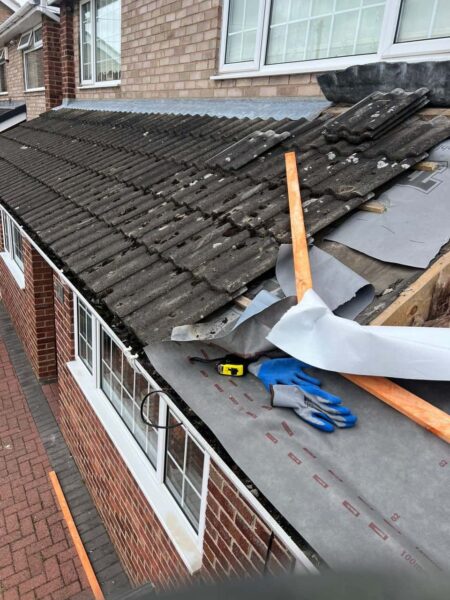What Causes Roof Tiles to Slip and How to Prevent It
Roof tiles are a critical component of your home’s protection against the elements, and when they slip, it can lead to serious damage. Roof tiles are designed to withstand harsh weather conditions and to stay firmly in place for many years. However, there are various factors that can cause roof tiles to slip, which may leave your home vulnerable to leaks, water damage, and further roof deterioration. In this article, we will explore the common causes of slipping roof tiles and how to prevent it, ensuring that your roof remains secure and efficient for years to come.
Common Causes of Roof Tiles Slipping
- Age and Wear Over time, roof tiles can become worn out due to exposure to the elements. Extreme weather, including heavy rain, wind, snow, and even the sun, can cause tiles to degrade. As roof tiles age, they may become brittle, leading them to crack, loosen, or slip out of place. Regular roof inspections are essential to identify signs of wear and tear before it leads to significant damage.
- Improper Installation If roof tiles are not installed properly, they are more likely to slip. Incorrect placement, poor alignment, or failing to use the correct type of nails or fasteners can result in tiles shifting or detaching altogether. Always ensure that a qualified roofing contractor installs or repairs your roof to prevent issues related to poor workmanship.
- Roof Movement Roofs are subject to movement due to settling, thermal expansion, and weather-related shifts. This movement can cause roof tiles to shift or slip out of place. If the roof structure is not properly supported or the tiles are not sufficiently secured, roof movement can lead to tile slippage over time.
- Debris and Blockages Accumulation of debris such as leaves, moss, and dirt can cause tiles to lift or shift. When debris builds up on the roof, it can exert pressure on the tiles, causing them to slip or become dislodged. Blocked gutters or downpipes can also lead to water pooling on the roof, putting additional strain on the tiles and potentially causing them to slip.
- Storm Damage Strong winds and storms can dislodge roof tiles, particularly if they are not properly secured. In some cases, a tile may slip or crack during a storm, leaving the underlying layers exposed to the elements. Even relatively minor storms can cause significant damage to poorly maintained roofs.
- Structural Issues If your roof has structural issues such as sagging or weakening beams, this can lead to uneven pressure on your roof tiles, causing them to move. If the roofing structure is not level or properly aligned, tiles may slip out of place more easily.
How to Prevent Roof Tiles from Slipping
- Regular Roof Inspections Regular roof inspections are essential to identify potential issues before they lead to tile slippage. A professional roofer will check for cracked, loose, or damaged tiles, ensuring that any problems are addressed quickly. Regular maintenance can also prevent the buildup of debris that might lead to tile movement.
- Proper Installation and Repairs Proper installation is key to ensuring that roof tiles remain secure. It’s essential to hire a skilled and experienced roofing contractor who understands the correct techniques and uses high-quality materials. If your roof tiles need repair or replacement, ensure that the contractor follows the best practices for tile installation, ensuring that the tiles are securely fastened and aligned properly.
- Use of Roof Adhesives In some cases, roof adhesives can be applied to help secure tiles in place. Specialised roofing adhesive can provide an additional layer of support, preventing tiles from slipping during windy conditions or heavy rainfall. However, this should only be done by a professional roofing contractor who understands when and where adhesives should be used.
- Maintaining Proper Drainage Ensure that your roof has proper drainage to prevent water from accumulating and causing tiles to shift. Clear gutters and downpipes regularly to prevent debris buildup. This will allow rainwater to flow freely and reduce the risk of water pooling on your roof. Proper drainage helps reduce the weight and pressure on your roof tiles, preventing them from becoming dislodged.
- Investing in Quality Materials If you’re replacing roof tiles or installing a new roof, investing in high-quality tiles and materials can make a significant difference. Quality tiles are more durable and less likely to degrade over time. Additionally, high-quality fasteners, nails, and adhesives can ensure that your roof remains intact even during extreme weather conditions.
- Strengthening the Roof Structure If your roof structure has been compromised or is showing signs of weakness, it’s important to address the underlying issue. A professional roofing contractor can reinforce the roof structure to prevent movement and ensure that the tiles stay in place. Proper roof support can eliminate uneven pressure, which often leads to slippage.
Conclusion
Slipping roof tiles can be a serious issue that compromises the integrity of your home and leaves it vulnerable to water damage. While there are many factors that can cause roof tiles to slip, proactive measures such as regular inspections, proper installation, maintaining drainage, and using high-quality materials can prevent tile slippage and ensure the longevity of your roof.
At HJT Roofing Gainsborough, we specialise in providing high-quality roofing repairs and maintenance services. Our experienced team can help with roof inspections, repairs, and preventative measures to keep your roof in top condition. If you’ve noticed slipping roof tiles or need assistance with your roof, don’t hesitate to contact us for professional and reliable roofing services. We’re here to help you protect your home and keep your roof secure.
Call us on: 01427 802 298
Click here to find out more about HJT Roofing Gainsborough
Click here to complete our contact form and see how we can help with your Roofing needs.

